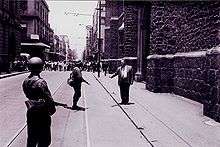Dirty War (Mexico)
| Dirty War | |||
|---|---|---|---|
| Part of the Cold War | |||
 Mexican Army soldiers in the streets during the 1968 Tlatelolco massacre. | |||
| |||
| Belligerents | |||
|
Left-wing groups | |||
The Dirty War (Spanish: Guerra Sucia) refers to the Mexican theater of the Cold War, an internal conflict between the Mexican PRI-ruled government, backed by the US, and left-wing student and guerrilla groups in the 1960s and 1970s under the presidencies of Luis Echeverría and José López Portillo.[1][2] During the war, government forces carried out disappearances, estimated at 1,200,[3] systematic torture, and "probable extralegal executions".[4]
Events
The war was characterized by a backlash against the active student movement of the late 1960s which terminated in the Tlatelolco massacre at a 1968 student rally in Mexico City,[4] in which 30 to 300 (official report, non-governmental sources claim thousands) students were killed, and by the Corpus Christi massacre, a massacre of student demonstrators in Mexico City on June 10, 1971.[1]
There were several barely connected groups fighting against the government during this period. Among the most important, the September 23 Communist League was at the forefront of the conflict, active in several cities throughout Mexico, drawing heavily from Christian Socialist and Marxist student organizations. They carried out confrontations with Mexican security forces, several kidnappings, and attempted to kidnap Margarita López Portillo, the sister of the president. In Guerrero, the Party of the Poor, ostensibly fighting against landholder impunity and oppressive police practices in rural areas, was led by the ex-teacher Lucio Cabañas; they carried out ambushes of the army and security forces and the abduction of Guerrero's governor-elect.[4]
The legalization of leftist political parties in 1978 along with the amnesty of imprisoned and at large guerrillas caused a number of combatants to end militant struggle against the government. However, certain groups continued fighting, and the National Human Rights Commission states the hostilities continued into 1982.[4]
In June 2002, a report prepared for Vicente Fox, the first president not from the Institutional Revolutionary Party (PRI) in 70 years, detailed the government's actions from 1964 to 1982. The report states, according to BBC News, that the Mexican army "kidnapped, tortured, and killed hundreds of rebel suspects" in the period and accused the Mexican state of genocide. The Mexican Special Prosecutor claimed the report was overly biased against the military, and failed to detail crimes committed by rebels, which included kidnappings, bank robberies, and assassinations.[4][5] However, there is a general consensus in the public opinion, that sees the government's actions as blameworthy in this types of conflicts, for instead of ensuring the security of innocent civilians, victimizing them and killing them alike.[6][7][8][9][10][11]
See also
- Central American crisis
- Operation Condor
- Mario Arturo Acosta Chaparro
- Rosario Ybarra
- Miguel Nazar Haro
- List of wars involving Mexico
References
- 1 2 Reuters Editorial (2007-04-05). "Rights group urges Mexico to resolve "dirty war"". Reuters. Retrieved 2016-10-29.
- ↑ Michael Evans. "The Dawn of Mexico's Dirty War". Gwu.edu. Retrieved 2016-10-29.
- ↑ Reuters Editorial (2008-07-08). "Mexico looks for 'dirty war' graves on army base". Reuters. Retrieved 2016-10-29.
- 1 2 3 4 5
- ↑ "Americas | Mexico 'dirty war' crimes alleged". BBC News. 2006-02-27. Retrieved 2016-10-29.
- ↑ Jornada, La. "Sedena extendió acciones de la guerra sucia contra campesinos inocentes - La Jornada". Retrieved 17 August 2016.
- ↑ "Desaparecidos. 'Guerra sucia' deja 480 víctimas". Eluniversal.com.mx. Retrieved 17 August 2016.
- ↑ "Padre de uno de los 43 admite que su hijo fue militar, pero "desertó" - Proceso". Procesco.com. 23 June 2015. Retrieved 17 August 2016.
- ↑ "EPN ha provocado una cacería brutal de inocentes por medio de escuadrones de la muerte: expertos". Revoluciontrespuntocero.com. Retrieved 17 August 2016.
- ↑
- ↑ "Urgente, una ley general de desaparición forzada". Animalpolitico.com. Retrieved 17 August 2016.